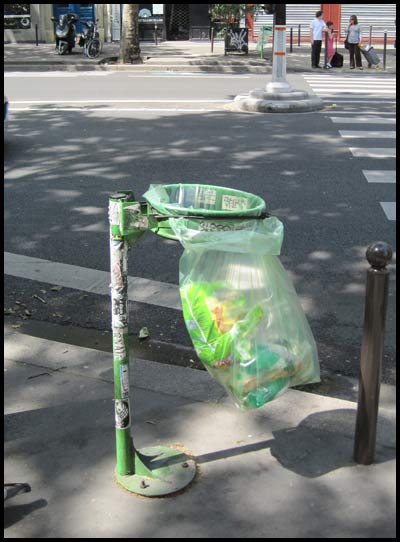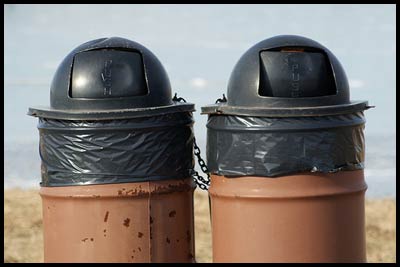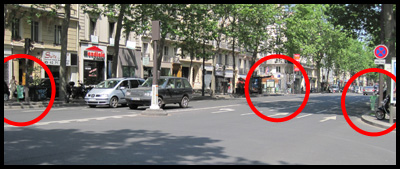I just got back from my first trip to Europe, where the cities are a lot older and a lot different than they are here in the New World. I made many observations on my brief trip, which included Paris and Barcelona, and I'm sure those will bubble up in blog posts in the near future. However, I won't waste anyone's time remarking about how great European cities are. We've all heard it before, and while it may be right, the point has been made. Like, really made. So, yes, the narrow streets are nice to walk on, the bike sharing system in Paris is awesome, and the architecture is impressive. But one piece of these cities that hasn't receioved enough praise is their garbage cans.
I just got back from my first trip to Europe, where the cities are a lot older and a lot different than they are here in the New World. I made many observations on my brief trip, which included Paris and Barcelona, and I'm sure those will bubble up in blog posts in the near future. However, I won't waste anyone's time remarking about how great European cities are. We've all heard it before, and while it may be right, the point has been made. Like, really made.
So, yes, the narrow streets are nice to walk on, the bike sharing system in Paris is awesome, and the architecture is impressive. But one piece of these cities that hasn't receioved enough praise is their garbage cans.
Specifically, I'm talking about Paris here, and more specifically, we can't even call them garbage cans. As you can see in the picture below (yes, I take pictures of garbage cans on vacation), these garbage "cans" are not much more than posts, hoops and plastic bags.

Now that's simple infrastructure. A post, a hoop and a bag. It's got to cost next to nothing to make one of these things – a lot less than a bulky concrete block or metal can like you see in many cities. But it gets the job done. Additionally, it makes trash collection really easy. A simple elastic bungee band holds the bag to the hoop, so all the trash collectors have to do is lift the band, take the bag, and add another. There's no reaching into a dark nasty can, no picking up and dumping out, and no gross garbage water pooling at the bottom for months or more.

A local friend tells me the reason behind this system is less about efficiency than safety. The simple post-hoop-bag replaced the traditional concrete can holder after miscreants had caused a bunch of damage in 1995 hiding bombs inside garbage cans. To reduce that threat, the cans were replaced with clear plastic bags. Now not much can hide in the new garbage cans of Paris.
An additional benefit that may not be relevant in Paris but which would certainly be a big improvement in American cities is that, in the same way that police can see bombs in a clear plastic bag, people who collect bottles and cans don't have to reach into a can (or turn it over) to see if there are any recyclables inside. It makes life easier for those who make their living this way, and cuts down on the mess that results from those who do so inconsiderately.
But garbage on the street isn't really a problem in Paris, or at least it wasn't in the places I went. The reason, I'm guessing, has a lot to do with the sheer amount of places to put garbage. The post-hoop-bag is ubiquitous in the city. It's hard to turn your head without seeing one. Or more.

This is a European model American cities should follow. Cities need garbage collection infrastructure, so it might as well be cheap. If it can also be highly dispersed, maintained efficiently and used effectively by the public, that's even better.
And if it does things really well, it might even end up in a photo album from some nerd's vacation.

Planetizen Federal Action Tracker
A weekly monitor of how Trump’s orders and actions are impacting planners and planning in America.

Chicago’s Ghost Rails
Just beneath the surface of the modern city lie the remnants of its expansive early 20th-century streetcar system.

Amtrak Cutting Jobs, Funding to High-Speed Rail
The agency plans to cut 10 percent of its workforce and has confirmed it will not fund new high-speed rail projects.

Ohio Forces Data Centers to Prepay for Power
Utilities are calling on states to hold data center operators responsible for new energy demands to prevent leaving consumers on the hook for their bills.

MARTA CEO Steps Down Amid Citizenship Concerns
MARTA’s board announced Thursday that its chief, who is from Canada, is resigning due to questions about his immigration status.

Silicon Valley ‘Bike Superhighway’ Awarded $14M State Grant
A Caltrans grant brings the 10-mile Central Bikeway project connecting Santa Clara and East San Jose closer to fruition.
Urban Design for Planners 1: Software Tools
This six-course series explores essential urban design concepts using open source software and equips planners with the tools they need to participate fully in the urban design process.
Planning for Universal Design
Learn the tools for implementing Universal Design in planning regulations.
Caltrans
City of Fort Worth
Mpact (founded as Rail~Volution)
City of Camden Redevelopment Agency
City of Astoria
City of Portland
City of Laramie





























